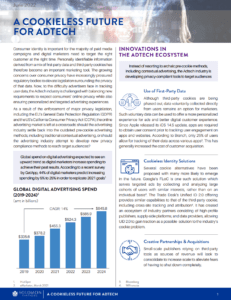 A Cookieless Future For Adtech
A Cookieless Future For Adtech
Consumer identity is important for the majority of paid media campaigns and digital marketers need to target the right customer at the right time. Personally identifiable information derived from a mix of first-party data and third-party cookies has therefore become an important marketing tool. The growing concerns over consumer privacy have increasingly pressured regulatory bodies to elevate legislation surrounding the privacy of that data. Now, to the difficulty advertisers face in tracking user data, the Adtech industry is challenged with balancing new requirements to respect consumers’ online privacy while also ensuring personalized and targeted advertising experiences.
As a result of the enforcement of major privacy legislation, including the EU’s General Data Protection Regulation (GDPR) and the US’s California Consumer Privacy Act (CCPA), the online advertising market is left at a crossroads: should the advertising industry settle back into the outdated pre-cookie advertising methods, including traditional contextual advertising, or should the advertising industry attempt to develop new privacy compliance methods to reach target audiences?
Global spend on digital advertising expected to see an upward trend as digital marketers increase spending to achieve their past results. According to a recent survey by GetApp, 44% of digital marketers predict increasing spending by 5% to 25% in order to replicate 2021 goals.
Instead of resorting to archaic pre-cookie methods, including contextual advertising, the Adtech industry is developing privacy-compliant tools to target audiences.
Use of First-Party Data
Although third-party cookies are being phased out, data voluntarily collected directly from users remains an option for marketers. Such voluntary data can be used to offer a more personalized experience for ads and better digital customer experience. Since Apple released its iOS 14.5 update, apps are required to obtain user consent prior to tracking user engagement on apps and websites. According to Branch, only 25% of users allow for tracking of their data across various apps. This has generally increased the cost of customer acquisition.
Cookieless Identity Solutions
Several cookie alternatives have been proposed with many more likely to emerge in the future. Google’s FLoC is one such solution which serves targeted ads by collecting and analyzing large cohorts of users with similar interests, rather than on an individual basis. The Trade Desk’s Unified ID 2.0 offering provides similar capabilities to that of the third-party cookie, including cross-site tracking and attribution. It has created an ecosystem of industry partners consisting of high-profile publishers, supply-side platforms, and data providers, allowing UID 2.0 to gain traction as a possible solution to the industry’s cookie problem.
Creative Partnerships & Acquisitions
Small-scale publishers relying on third-party tools as sources of revenue will look to consolidate to increase scale to alleviate fears of having to shut down completely.
Select Investments in Adtech ID Solutions
Since 2021, the push to address user privacy concerns has led to over $7 billion in identity solutions investments and $4 billion in measurement startups.
Winning the race of the post-cookie era is a multibillion-dollar opportunity and investors are expected to continue to invest heavily.
Click below to read the article from the Media & Entertainment Group.
Read the Article


